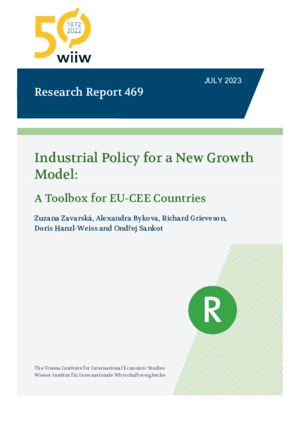Industrial Policy for a New Growth Model: A Toolbox for EU-CEE Countries
Alexandra Bykova, Rumen Dobrinsky, Richard Grieveson, Maciej J. Grodzicki, Doris Hanzl-Weiss, Gabor Hunya, Niko Korpar, Sebastian Leitner, Bernhard Moshammer, Ondřej Sankot, Bernd Christoph Ströhm, Maryna Tverdostup and Zuzana Zavarská
wiiw Research Report No. 469, July 2023
145 pages including 26 Tables, 50 Figures and 6 Boxes
The EU member states of Central Eastern Europe (EU-CEE) have experienced rapid convergence in the decades following their EU accession, and have built up strong export-oriented manufacturing sectors boosted by foreign direct investment inflows. While this growth model has brought many positives, there are indications that it is hitting its limits. Endogenous limits to EU-CEE’s growth model are exacerbated by exogenous challenges of the ‘twin’ (green and digital) transitions, and the fallout of the pandemic and Russian invasion of Ukraine.
This reinforces the imperative for EU-CEE to transition to a more innovation-driven, new growth model, enabled by a comprehensive industrial policy. However, the EU-CEE countries have not only lacked a stable and strategic approach to industrial policy in their development paths, but also find themselves in a unique position due to EU membership. As a result, innovation and industrial policies are underdeveloped in the region. Based on an in-depth analysis of the industrial landscape and the industrial policy environment of the region, we propose eight pillars for creating a EU-CEE version of the entrepreneurial state.
Keywords: industrial policy, EU-CEE, convergence, transition, green, digital
JEL classification: L52, O25, F63, L60, P27, O40
Countries covered: Bulgaria, Croatia, Czechia, Estonia, EU-CEE, Hungary, Latvia, Lithuania, Poland, Romania, Slovakia, Slovenia
Research Areas: International Trade, Competitiveness and FDI, Sectoral studies
